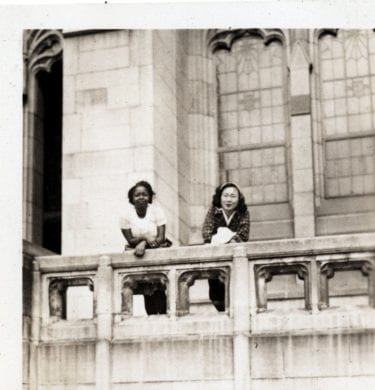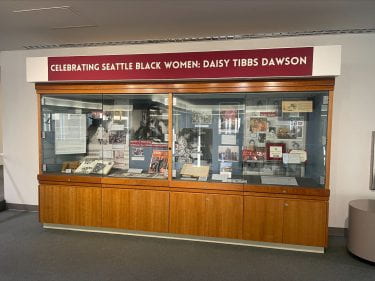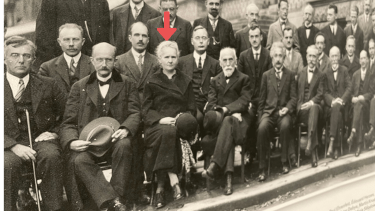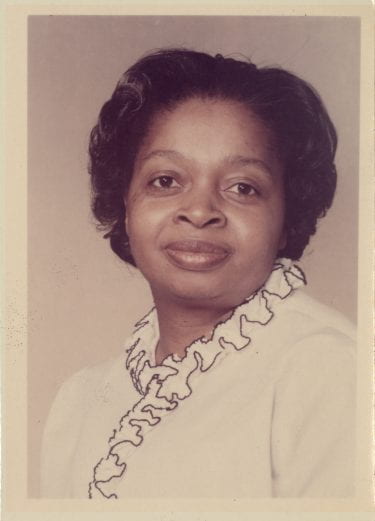March 7, 2023
Women’s History Month: Exhibits Highlight Amazing Women
From one trailblazing fellow husky to an international hero of medicine and science, these UW Libraries’ exhibits explore the lives of two amazing women.
Celebrating Seattle Black Women: Daisy Tibbs Dawson
University of Washington’s Special Collections has dug into its own archive to celebrate the life and work of a UW grad who waged peace here in Seattle and abroad.
Daisy Tibbs Dawson (nee Daisy Lee Tibbs) was a local peace activist, community leader, and director of Head Start. She was born in Alabama and moved to Seattle after graduating from high school. She was one of only sixty-five Black students at the University of Washington, where she graduated with a degree in Home Economics in 1948.

on the steps of Suzzallo
In the summer of 1949 Daisy took a detour to Hiroshima, Japan, where she joined Floyd Schmoe and a small group of volunteers to build houses in the still-devastated city. Her unusual adventure captured the attention of Ebony Magazine, which covered her in a feature article for the January 1950 edition.
After returning to Seattle, Dawson married, started a family, and began her long career as an educator. She served as the director of Head Start from 1971 until her retirement in 1984, touching the lives of thousands of children during her tenure. She was also a lifelong member and leader in the Madrona Grace Presbyterian Church and Delta Sigma Theta, a public service sorority.
You can find and study the Daisy Lee Tibbs Dawson papers and the papers of many other local Black heroes and heroines in Special Collections, located in the basement of Allen Library.
Visit the Daisy Tibbs Dawson exhibit on the first-floor mezzanine in North Allen Library through the end of March 2023 or view the online exhibit.

 The Lady of Radium: Maria Skłodowska-Curie (Marie Curie)
The Lady of Radium: Maria Skłodowska-Curie (Marie Curie)
In celebration of the centennial of Maria Curie’s first visit to the United States in 1921, the Embassy of the Republic of Poland has created an exhibit “The Lady of Radium: The Life of Maria Skłodowska – Curie.” The exhibit focuses on the life and legacy of the two-time Nobel Prize winning scientist, her extensive tour of the United States, and her support of Poland’s scientific development.
A pioneer in the applications of radiation within healthcare, Marie Curie is another woman to remember and celebrate during Women’s History Month. Maria Skłodowska-Curie was born in Warsaw, Poland in 1867, during the Russian occupation. Russian oppression of Polish people worsened throughout her childhood and her college education was largely underground as a result.
Dedicated to expanding scientific discovery and access to science, Marie was not only the first woman to be a professor at the University of Paris, but the first female member of the Academy of Arts and Sciences in Krakow.

She and her husband Pierre discovered Polonium and Radium, receiving a Nobel prize in physics. A few years later, Maria would receive a Nobel Prize in chemistry, making her the only person to receive two Nobel prizes in different scientific fields.
 Marie advanced cancer treatment research through the use of radium, a practice then known as telecurie therapy. She also became the Director of the Red Cross Radiology Services during WWI, and promoted the use of x-rays across the field of medicine.
Marie advanced cancer treatment research through the use of radium, a practice then known as telecurie therapy. She also became the Director of the Red Cross Radiology Services during WWI, and promoted the use of x-rays across the field of medicine.
In May of 1921, Marie received numerous honorary degrees and awards during her tour through various institutions in the US, and met with President Warren Harding, who gifted her a gram of radium. Eight years later she received an award from President Herbert Hoover to obtain another gram of radium to further her radiology research.
In 1932, Marie founded the Radium Institute in Warsaw, or what is now known as the Maria Sklowdowska-Curie National Research Institute of Oncology.
###

